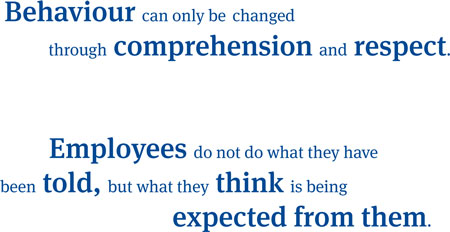Abschnitt 8 - 8 Dialogue-oriented instructions
with the help of brainstorming meetings
Reason
Instructions must be sufficient and appropriate and adapt to the risk development. The brainstorming meetings allow you to give employee-oriented instructions. This method includes risk perception of managers and employees alike. Handling of risk is clearly defined and coordinated with all employees.
As an employer, you can carry out the instructions personally. However, you can also assign an authorized manager or a specialist. It is important that the stipulated or recommended specialized information be well-known and integrated. Options for implementation can be discussed with the employees at the respective workplace in the instruction discussion.
Aim
provide information on current risks
find solutions for handling risks together with the employees
specify a joint approach
Components of the meeting
- 1.
Refer to and justify the subject
What have I seen? What have I experienced? Why is this subject important to me as employer?
The significance of the subject must be clearly defined. Therefore, current topics and/or unsafe or unclear situations should be used for instructions. - 2.
Describe risks from the perspective of the persons involved
What might happen when performing the task? Which risks or impacts are perceived by managers or employees?
- 3.
Discuss specialized information
What must be complied with according to statutory stipulations? Which code of conduct is set forth in the company ruling? What is important from the professional perspective?
- 4.
Compile measures and alternatives in behaviour
What can we do?
Use the brainstorming meetings for finding a solution: As you have already chosen one subject to be discussed, you can directly start with step 3 "finding solutions".
Compile measures demonstrated by "using skin protection"
What will be achieved/different once we have reached our goal?
e.g. "everybody uses skin protection cream several times a day" (express this positively!)
What can each employee contribute today or tomorrow to achieve the goal?
e.g. "I will use skin protection cream each time after washing hands" (proactiveness)
What can we do to maintain this situation?
e. g. "We check whether the used skin protection is suitable and kept in such a way that it is easily accessible for all employees", "We remind each other to use skin protection" (short and medium-term planning)
What are the positive and negative impacts of achieving the goals?
e.g. positive: "Everybody accepts skin protection as a vital measure of personal protection", negative: "Everybody must be disciplined" or "some feel observed and controlled".
- 5.
Specification of measures and code of conduct
The defined measures will be adopted after consent of all persons involved. In the next meeting, the successes of implementation are outlined in brief (cf. step "0").
Potential pitfalls
 | The specialized information becomes less important Experiences of the persons involved are not compared with the recommendations of the specialists. |
|---|---|
 | Proposed Solution: Through the use of recommended instructions tools essential specialized information can be discussed together from which rules of conduct can be derived from. |
 | Only organizational measures are discussed and specified. The conduct of individual employees is scarcely/not discussed. |
 | Proposed Solution: It is stipulated that in each instruction at least one rule of
conduct must be defined. This motivates proactiveness. Furthermore, it should be clearly pointed out that safety and health of each employee can only be achieved through the active involvement of all. |

